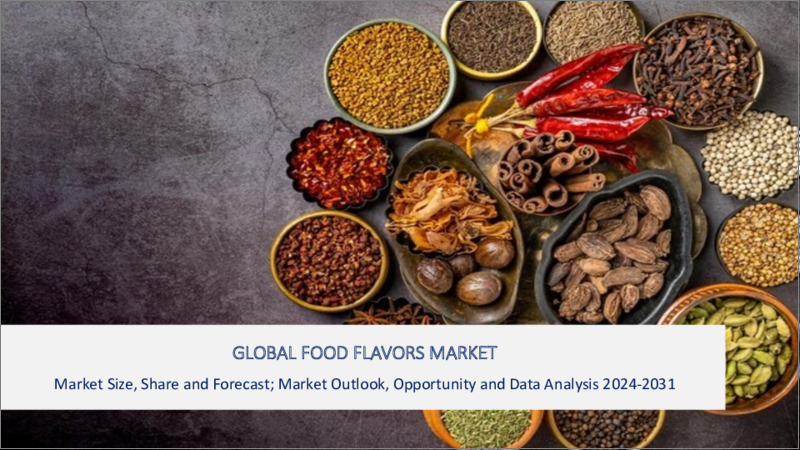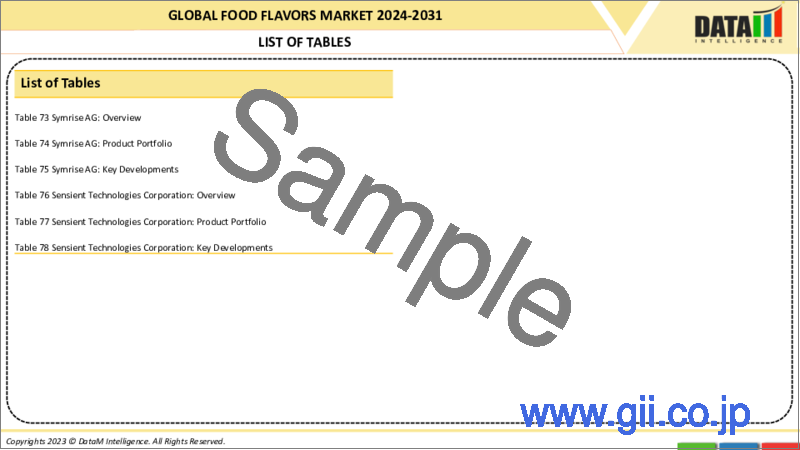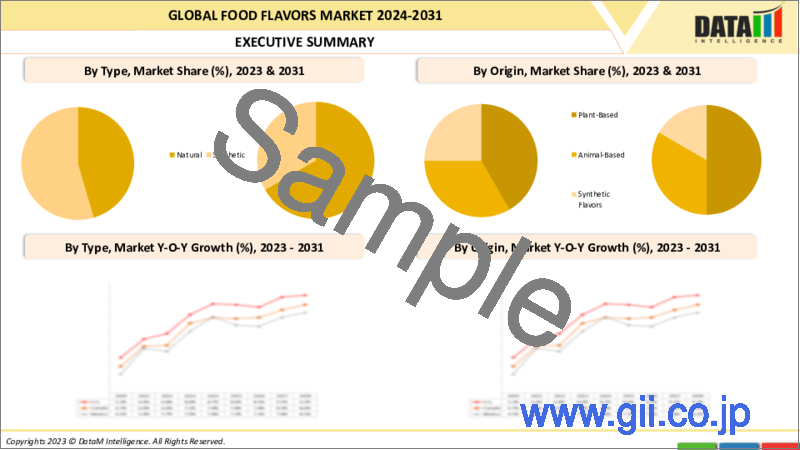|
|
市場調査レポート
商品コード
1325320
食品フレーバーの世界市場-2023年~2030年Global Food Flavors Market - 2023-2030 |
||||||
カスタマイズ可能
適宜更新あり
|
|||||||
| 食品フレーバーの世界市場-2023年~2030年 |
|
出版日: 2023年08月04日
発行: DataM Intelligence
ページ情報: 英文 190 Pages
納期: 即日から翌営業日
|
- 全表示
- 概要
- 目次
市場概要
世界の食品フレーバー市場は、2022年に147億米ドルに達し、2023年から2030年の予測期間中にCAGR 4.9%で成長し、2030年には215億米ドルに達すると予測されています。
天然フレーバーは、果物、野菜、ハーブ、スパイス、その他の動植物原料などの天然源から得られます。これらは、物理的抽出、蒸留、発酵プロセスを通じて得られます。天然フレーバーは、その本物の味が珍重され、より健全な選択肢を求める消費者に好まれることが多いです。
香味料は、食品の味と香りを強化または変更するために使用される物質です。特定の風味を提供し、食品をより魅力的で楽しいものにするために添加されます。
消費者は、食体験に興奮とバラエティーを加えるため、ユニークで世界な風味をますます求めるようになっています。中東、アジア、中南米など、さまざまな料理のフレーバーが、主流食品で人気を集めています。
市場力学
エスニック風味やエキゾチック風味に対する消費者の関心の高まりが食品フレーバー市場を牽引しています。
多様な料理の人気の高まりとエスニック・レストランの世界の増加は、エスニックでエキゾチックなフレーバーへの関心の高まりを示します。消費者は伝統的な料理の枠を超えたユニークで本格的な味覚体験を求めています。ソーシャルメディア・プラットフォームの普及が、エスニックでエキゾチックな味への憧れに拍車をかけています。ユーザーは自分の料理体験、食の発見、レシピを共有し、他の人々に新しくエキサイティングな味を紹介しています。ソーシャルメディア・コンテンツのバイラル性は、エスニックでエキゾチックな味をより多くの人々に広めることに貢献しています。
海外旅行がより身近になり、異文化や料理を直接体験できるようになっています。旅行者はしばしば、海外で出会った味に好意を抱くようになり、帰国後にその味に対する需要の増加につながります。FONA Internationalの報告書によると、世界の消費者の66%が、より多様なエスニック料理を食べるようになっています。グローバリゼーションと文化交流は、エスニック・エキゾチックフレーバーの人気をさらに高めています。
フレーバー作成における技術の進歩が食品フレーバー市場を促進すると予想される
カプセル化技術が進歩し、食品加工中または消費中の特定の段階でフレーバー化合物を保護・放出できるようになっています。この技術により、フレーバーの放出をより適切に制御できるようになり、全体的な味覚体験が改善されます。フレーバーをカプセル化する能力は、その安定性を高め、保存期間を延長し、新たなフレーバー用途の開発を可能にします。
フレーバー調整技術の進歩により、メーカーはフレーバーの感覚を微調整し、調整することができます。この技術により、甘味、苦味、塩味など、特定の味覚を強化または低減することができます。フレーバー調節は、消費者の嗜好に合わせてフレーバーを調整し、独自の味覚プロファイルを作り出す柔軟性を提供します。
原材料価格の変動が食品フレーバー市場の足かせに
果物、ハーブ、スパイスなど、フレーバー製造に使用される原材料の多くは農産物です。これらの商品は、天候、需給の動き、地政学的な出来事など様々な要因によって価格が変動します。異常気象や不作は、原料の供給減や価格上昇につながり、フレーバーメーカーのコストに影響を与えます。
国際貿易は食品フレーバー市場において重要な役割を果たしており、原料は世界各地の様々な地域から調達されることが多いです。貿易紛争、輸出入規制、輸送の途絶は、サプライチェーンの途絶を引き起こし、原材料の入手可能性と価格に影響を与える可能性があります。地政学的な出来事、貿易政策の変更、自然災害は、原料価格に予測不可能性をもたらす可能性があります。
COVID-19の影響
パンデミックは、フレーバー製造に使用される原材料の調達や輸送を含む、世界サプライチェーンの混乱につながっています。封鎖措置、国際貿易の制限、労働力の減少がサプライチェーンの円滑な機能に影響を及ぼし、フレーバーメーカーにとって原材料の遅延や不足の可能性が生じました。パンデミックは消費者の行動や嗜好を変化させ、食品の消費パターンに変化をもたらしました。消費者は家庭で過ごす時間が長くなり、その結果、調理用および製パン用の原材料の需要が増加しました。この消費者行動の変化は、需要のあるフレーバーの種類に影響を与え、ホームベーキングフレーバー、コンフォートフードフレーバー、パントリーの定番フレーバーが人気を集めました。
目次
第1章 調査手法と調査範囲
第2章 市場の定義と概要
第3章 エグゼクティブサマリー
第4章 市場力学
- 市場への影響要因
- 促進要因
- 抑制要因
- 機会
- 影響分析
第5章 産業分析
- ポーターのファイブフォース分析
- サプライチェーン分析
- 価格分析
- 規制分析
第6章 COVID-19分析
第7章 タイプ別
- 人工
- 天然
第8章 用途別
- 飲料
- 乳製品・冷凍食品
- ベーカリー・菓子類
- セイボリー・スナック
- 動物・ペットフード
第9章 地域別
- 北米
- 米国
- カナダ
- メキシコ
- 欧州
- ドイツ
- 英国
- フランス
- イタリア
- スペイン
- その他欧州
- 南米
- ブラジル
- アルゼンチン
- その他南米
- アジア太平洋
- 中国
- インド
- 日本
- オーストラリア
- その他アジア太平洋
- 中東・アフリカ
第10章 競合情勢
- 競合シナリオ
- 市況/シェア分析
- M&A分析
第11章 企業プロファイル
- Archer Daniels Midland
- 企業概要
- 製品ポートフォリオと説明
- 財務概要
- 主な動向
- Takasago International Corporation
- Huabao International Holdings Limited
- Symrise AG
- Kerry Group, Plc.
- Firmenich SA
- Robertet SA
- Frutarom Industries Ltd.
- Sensient Technologies Corporation
- Givaudan International SA
第12章 付録
Market Overview
Global Food Flavors Market reached US$ 14.7 billion in 2022 and is expected to reach US$ 21.5 billion by 2030 growing with a CAGR of 4.9% during the forecast period 2023-2030.
Natural flavors are derived from natural sources such as fruits, vegetables, herbs, spices, or other plant and animal materials. They are obtained through physical extraction, distillation, or fermentation processes. Natural flavors are prized for their authentic taste and are often preferred by consumers seeking more wholesome options.
Flavoring agents are substances used to enhance or modify the taste and aroma of food products. They are added to provide a specific flavor profile, making the food more appealing and enjoyable to consume.
Consumers are increasingly seeking unique and globally inspired flavours to add excitement and variety to their food experiences. Flavors from different cuisines, such as Middle Eastern, Asian, and Latin American, are gaining popularity in mainstream food products.
Market Dynamics
Rising Consumers' Interest in Ethnic and Exotic Flavors is Driving the Food Flavors Market
The growing popularity of diverse cuisines and the increasing number of ethnic restaurants globally indicate a rising interest in ethnic and exotic flavors. Consumers are seeking unique and authentic taste experiences beyond their traditional culinary boundaries. The prevalence of social media platforms has fueled the fascination with ethnic and exotic flavors. Users share their culinary experiences, food discoveries, and recipes, exposing others to new and exciting flavors. The viral nature of social media content contributes to the spread of ethnic and exotic flavors among a broader audience.
International travel has become more accessible, allowing individuals to experience different cultures and cuisines firsthand. Travelers often develop a fondness for the flavors they encounter abroad, leading to increased demand for those flavors when they return home. According to a report by FONA International, 66% of consumers worldwide are eating a greater variety of ethnic foods. Globalization and cultural exchange further contribute to the popularity of ethnic and exotic flavors.
Technological Advancements in Flavor Creation is Expected to Foster the Food Flavors Market
Encapsulation techniques have advanced, enabling flavor compounds to be protected and released at specific stages during food processing or consumption. This technology allows for better control over flavor release, improving the overall taste experience. The ability to encapsulate flavors enhances their stability, prolongs shelf life, and enables the development of new flavor applications.
Advancements in flavor modulation techniques allow manufacturers to fine-tune and adjust the sensory perception of flavors. This technology can enhance or reduce specific taste sensations such as sweetness, bitterness, or saltiness. Flavor modulation offers the flexibility to tailor flavors to meet consumer preferences and create unique taste profiles.
Raw Material Price Volatility is Holding Back the Food Flavors Market
Many raw materials used in flavor production, such as fruits, herbs, and spices, are agricultural commodities. These commodities are subject to price fluctuations influenced by various factors such as weather conditions, supply and demand dynamics, and geopolitical events. Instances of extreme weather events or crop failures can lead to reduced supply and increased prices of raw materials, impacting flavor manufacturers' costs.
International trade plays a significant role in the food flavors market, with raw materials often sourced from different regions globally. Trade disputes, import/export regulations, and transportation disruptions can cause supply chain disruptions and impact the availability and pricing of raw materials. Geopolitical events, changes in trade policies, or natural disasters can introduce unpredictability into raw material prices.
COVID-19 Impact
The pandemic led to disruptions in global supply chains, including the sourcing and transportation of raw materials used in flavor production. Lockdown measures, restrictions on international trade, and reduced workforce availability affected the smooth functioning of supply chains, causing delays and potential shortages of raw materials for flavor manufacturers. The pandemic altered consumer behavior and preferences, leading to changes in food consumption patterns. Consumers spent more time at home, resulting in increased demand for cooking and baking ingredients. This shift in consumer behavior influenced the types of flavors in demand, with home baking flavors, comfort food flavors, and pantry staple flavors gaining popularity.
Segment Analysis
The global food flavors market is segmented based on type, application, and region.
By Application, the Beverages Segment is Estimated to Have Significant Growth During the Forecast Period
Beverages have long been a staple in the daily lives of consumers worldwide. The global beverage industry encompasses a wide range of categories, including carbonated soft drinks, juices, energy drinks, functional beverages, ready-to-drink teas and coffees, and alcoholic beverages. The extensive consumer base and consumption patterns of beverages contribute to the segment's market share.
Beverages offer ample opportunities for flavor innovation and differentiation. Flavor plays a crucial role in the success of beverages, as it adds taste, aroma, and overall sensory appeal. From fruit-flavored sodas to exotic-flavored craft beers, the beverage industry constantly introduces new flavors to cater to evolving consumer preferences.
Geographical Analysis
North America is the Fastest Growing Market in the Food Flavors Market
Consumers in North America are numerous and diversified, with ever-evolving taste preferences and an inclination toward trying new foods. A growing number of food lovers, health-conscious people, and people looking for unusual flavor experiences live in the region. According to USDA, food & beverages processing facilities accounted for 15.8% of total shipments and 14.7% of all U.S. manufacturing plant employment. The North American market for food flavors is expanding as a result of this demand.
The cultural form of North America and the have an impact on numerous ethnic cuisines are well-known. The vicinity celebrates international flavors, creating a dynamic and sundry cuisine culture. Customers in North America are attracted to genuine and ethnic flavors, which fuels the market's want for a huge form of culinary flavors.
Competitive Landscape
The major global players in the market include Archer Daniels Midland, Takasago International Corporation, Huabao International Holdings Limited, Symrise AG, Kerry Group, Plc., Firmenich SA, Robertet SA, Frutarom Industries Ltd., Sensient Technologies Corporation, and Givaudan International SA.
Why Purchase the Report?
- To visualize the global food flavors market segmentation based on type, application, and region, as well as understand key commercial assets and players.
- Identify commercial opportunities in the market by analyzing trends and co-development.
- Excel data sheet with numerous data points of food flavors market-level with all segments.
- The PDF report consists of cogently put-together market analysis after exhaustive qualitative interviews and an in-depth market study.
- Product mapping is available as Excel consists of key products of all the major market players.
The global food flavors market report would provide approximately 53 tables, 48 figures and 190 Pages.
Target Audience 2023
- Manufacturers/ Buyers
- Industry Investors/Investment Bankers
- Research Professionals
- Emerging Companies
Table of Contents
1. Methodology and Scope
- 1.1. Research Methodology
- 1.2. Research Objective and Scope of the Report
2. Market Definition and Overview
3. Executive Summary
- 3.1. Market Snippet, by Type
- 3.2. Market Snippet, by Application
- 3.3. Market Snippet, by Region
4. Market Dynamics
- 4.1. Market Impacting Factors
- 4.1.1. Drivers
- 4.1.2. Restraints
- 4.1.3. Opportunity
- 4.1.4. Impact Analysis
5. Industry Analysis
- 5.1. Porter's Five Force Analysis
- 5.2. Supply Chain Analysis
- 5.3. Pricing Analysis
- 5.4. Regulatory Analysis
6. COVID-19 Analysis
- 6.1. Analysis of COVID-19
- 6.1.1. Scenario Before COVID-19
- 6.1.2. Scenario During COVID-19
- 6.1.3. Scenario Post COVID-19
- 6.2. Pricing Dynamics Amid COVID-19
- 6.3. Demand-Supply Spectrum
- 6.4. Government Initiatives Related to the Market During Pandemic
- 6.5. Manufacturers Strategic Initiatives
- 6.6. Conclusion
7. By Type
- 7.1. Introduction
- 7.1.1. Market Size Analysis and Y-o-Y Growth Analysis (%), By Type
- 7.1.2. Market Attractiveness Index, By Type
- 7.2. Artificial*
- 7.2.1. Introduction
- 7.2.2. Market Size Analysis and Y-o-Y Growth Analysis (%)
- 7.3. Natural
8. By Application
- 8.1. Introduction
- 8.1.1. Market Size Analysis and Y-o-Y Growth Analysis (%), By Application
- 8.1.2. Market Attractiveness Index, By Application
- 8.2. Beverages*
- 8.2.1. Introduction
- 8.2.2. Market Size Analysis and Y-o-Y Growth Analysis (%)
- 8.3. Dairy & Frozen Products
- 8.4. Bakery & Confectionery
- 8.5. Savory & Snacks
- 8.6. Animal & Pet Food
9. By Region
- 9.1. Introduction
- 9.1.1. Market Size Analysis and Y-o-Y Growth Analysis (%), By Region
- 9.1.2. Market Attractiveness Index, By Region
- 9.2. North America*
- 9.2.1. Introduction
- 9.2.2. Key Region-Specific Dynamics
- 9.2.3. Market Size Analysis and Y-o-Y Growth Analysis (%), By Type
- 9.2.4. Market Size Analysis and Y-o-Y Growth Analysis (%), By Application
- 9.2.5. Market Size Analysis and Y-o-Y Growth Analysis (%), By Country
- 9.2.5.1. The U.S.
- 9.2.5.2. Canada
- 9.2.5.3. Mexico
- 9.3. Europe
- 9.3.1. Introduction
- 9.3.2. Key Region-Specific Dynamics
- 9.3.3. Market Size Analysis and Y-o-Y Growth Analysis (%), By Type
- 9.3.4. Market Size Analysis and Y-o-Y Growth Analysis (%), By Application
- 9.3.5. Market Size Analysis and Y-o-Y Growth Analysis (%), By Country
- 9.3.5.1. Germany
- 9.3.5.2. The U.K.
- 9.3.5.3. France
- 9.3.5.4. Italy
- 9.3.5.5. Spain
- 9.3.5.6. Rest of Europe
- 9.4. South America
- 9.4.1. Introduction
- 9.4.2. Key Region-Specific Dynamics
- 9.4.3. Market Size Analysis and Y-o-Y Growth Analysis (%), By Type
- 9.4.4. Market Size Analysis and Y-o-Y Growth Analysis (%), By Application
- 9.4.5. Market Size Analysis and Y-o-Y Growth Analysis (%), By Country
- 9.4.5.1. Brazil
- 9.4.5.2. Argentina
- 9.4.5.3. Rest of South America
- 9.5. Asia-Pacific
- 9.5.1. Introduction
- 9.5.2. Key Region-Specific Dynamics
- 9.5.3. Market Size Analysis and Y-o-Y Growth Analysis (%), By Type
- 9.5.4. Market Size Analysis and Y-o-Y Growth Analysis (%), By Application
- 9.5.5. Market Size Analysis and Y-o-Y Growth Analysis (%), By Country
- 9.5.5.1. China
- 9.5.5.2. India
- 9.5.5.3. Japan
- 9.5.5.4. Australia
- 9.5.5.5. Rest of Asia-Pacific
- 9.6. Middle East and Africa
- 9.6.1. Introduction
- 9.6.2. Key Region-Specific Dynamics
- 9.6.3. Market Size Analysis and Y-o-Y Growth Analysis (%), By Type
- 9.6.4. Market Size Analysis and Y-o-Y Growth Analysis (%), By Application
10. Competitive Landscape
- 10.1. Competitive Scenario
- 10.2. Market Positioning/Share Analysis
- 10.3. Mergers and Acquisitions Analysis
11. Company Profiles
- 11.1. Archer Daniels Midland*
- 11.1.1. Company Overview
- 11.1.2. Product Portfolio and Description
- 11.1.3. Financial Overview
- 11.1.4. Key Developments
- 11.2. Takasago International Corporation
- 11.3. Huabao International Holdings Limited
- 11.4. Symrise AG
- 11.5. Kerry Group, Plc.
- 11.6. Firmenich SA
- 11.7. Robertet SA
- 11.8. Frutarom Industries Ltd.
- 11.9. Sensient Technologies Corporation
- 11.10. Givaudan International SA
LIST NOT EXHAUSTIVE
12. Appendix
- 12.1. About Us and Services
- 12.2. Contact Us





